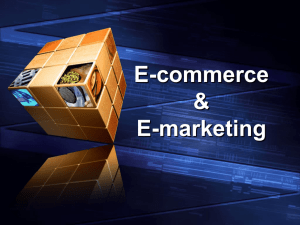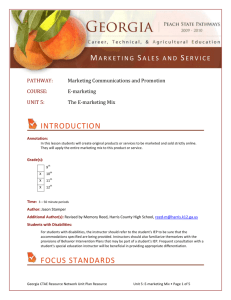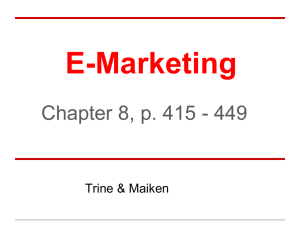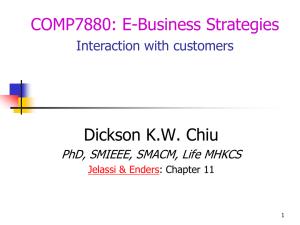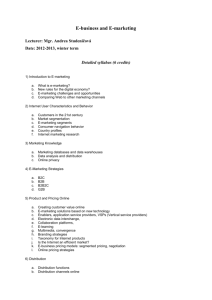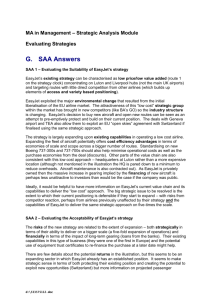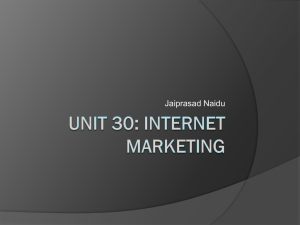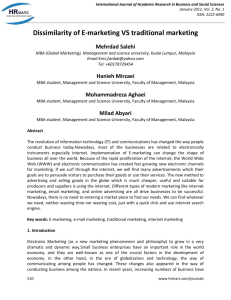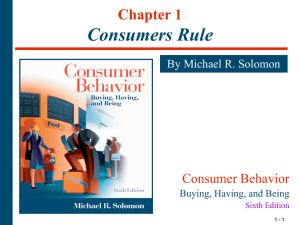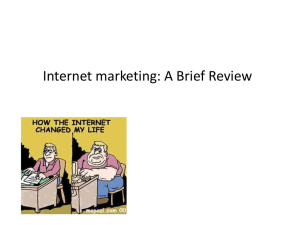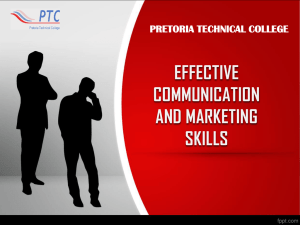Name of Presentation! - Welcome!!! Welcome to my website, which
advertisement
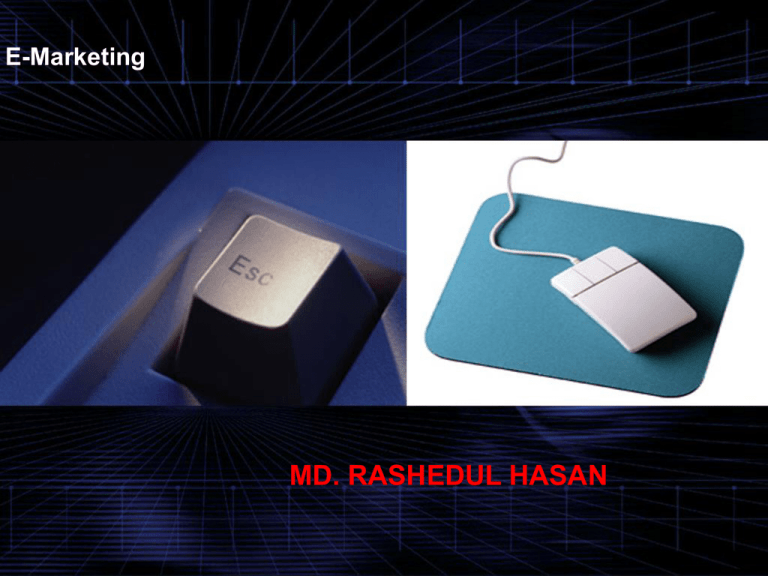
E-Marketing MD. RASHEDUL HASAN How significant is the Internet for marketing? • The relative importance of the Internet for marketing for an organization still largely depends on the nature of its products and services and the buyer behavior of its target audience. • easyJet (www.easyjet.com), the low-cost European airline, the Internet is very significant for marketing its products. EasyJet now achieves over 95% of its ticket sales online and aims to fulfill the majority of its customer service requests via the Internet. • For organizations whose products are not generally appropriate for sale online, such as energy company BP (www.bp.com) or consumer brands such as Unilever (www.unilever.com), the Internet is less significant, but is still rapidly growing in importance. What is E-marketing? E Marketing stands for Electronic Marketing. It also referred to as web marketing, online marketing, or Internet Marketing. E marketing is the marketing of products or services over the Internet. Internet marketing can be simply defined as, “Achieving marketing objectives through applying digital technologies.” In practice, Internet marketing will include the use of a company web site in combination with online promotional techniques such as search engine marketing, interactive advertising, e-mail marketing and partnership arrangements with other web sites. However, for Internet marketing to be successful there is still a necessity for integration of these techniques with traditional media such as print, TV and direct mail. E Marketing is the product of the meeting between modern communication technologies and the age-old marketing principles that humans have always applied. The Role of E-marketing According to the Chartered Institute of Marketing (www.cim.co.uk) The role of e-marketing, • Identifying – the Internet can be used for marketing research to find out customers’ needs and wants. • Anticipating – the Internet provides an additional channel by which customers can access information and make purchases. • Satisfying – a key success factor in e-marketing is achieving customer satisfaction through the electronic channel, which raises issues such as: is the site easy to use, does it perform adequately, what is the standard of associated customer service and how are physical products dispatched? MARKETING APPLICATIONS OF INTERNET MARKETING • An advertising medium. For example, BP plc and its subsidiary companies, such as Castrol Limited, uses large-format display or interactive ads on media sites to create awareness of brands and products such as fuels and lubricants. • A direct-response medium. For example, easyJet uses sponsored links when a user is researching a flight using a search engine to prompt them to directly visit the easyJet site by clicking through to it. Similarly the easyJet e-mail newsletter sent to customers can encourage them to click through to a web site to generate sales. • A platform for sales transactions. For example, easyJet sells flights online to both consumers and business travelers. • A lead-generation method. For example, when BP offers content to business car managers about selecting the best fuel for company cars in order to identify interest from a car fleet manager. MARKETING APPLICATIONS OF INTERNET MARKETING • A distribution channel. For example, for distributing digital products. This is often specific to companies with digital products to sell such as online music resellers such as Napster (www.napster.com) and Apple iTunes (www.itunes.com) or publishers of written or video content. • A customer service mechanism. For example, customers serve themselves on easyJet.com by reviewing frequently asked questions. • A relationship-building medium where a company can interact with its customers to better understand their needs and offer them relevant products and offers. For example, easyJet uses its e-mail newsletter and tailored alerts about special deals to help keep its customers and engage them in a dialogue to understand their needs through completing surveys and polls. Our changing media consumption OUR CHANGING BUYER BEHAVIOR CHARACTERISTICS OF EMARKETING • The Internet has brought many unique benefits to marketing, one of which being lower costs for the distribution of information and media to a global audience. The interactive nature of Internet marketing, both in terms of providing instant response and eliciting responses, is a unique quality of the medium. Internet marketing is sometimes considered to have a broader scope because it refers to digital media such as the Internet, e-mail, and wireless media; however, Internet marketing also includes management of digital customer data and electronic customer relationship management (ECRM) systems. • E Marketing is the process of marketing a brand using the Internet. It includes both direct response marketing and indirect marketing elements and uses a range of technologies to help connect businesses to their customers. CHARACTERISTICS OF EMARKETING • Internet marketing ties together creative and technical aspects of the Internet, including design, development, advertising, and sales. • Internet marketing does not simply entail building or promoting a website, nor does it mean placing a banner ad on another website. Effective Internet marketing requires a comprehensive strategy that synergizes a given company's business model and sales goals with its website function and appearance, focusing on its target market through proper choice of advertising type, media, and design. WHAT ARE THE E-MARKETING TOOLS? The Internet has a number of tools to offer to the marketer. • A company can distribute via the Internet e.g. Amazon.com. • A company can use the Internet as a way of building and maintaining a customer relationship e.g. Dell.com. • The money collection part of a transaction could be done online e.g. electricity and telephone bills. • Leads can be generated by attracting potential customers to sign-up for short periods of time, before signing up for the longterm e.g. which.co.uk. • The Internet could be used for advertising e.g. Google Adwords. • Finally, the web can be used as a way of collecting direct responses e.g. as part of a voting system for a game show. DIFFERENCES FROM TRADITIONAL MARKETING • One-to-one approach The targeted user is typically browsing the Internet alone, so the marketing messages can reach them personally. This approach is used in search marketing, where the advertisements are based on search engine keywords entered by the user. • Appeal to specific interests Internet marketing places an emphasis on marketing that appeal to a specific behavior or interest, rather than reaching out to a broadly defined demographic area. "On- and Off-line" marketers typically segment their markets according to age group, gender, geography, and other general factors. Marketers have the luxury of targeting by activity and geo-location. For example, a kayak company can post advertisements on kayaking and canoeing websites with the full knowledge that the audience has a related interest. • Effective Market Targeting Internet marketing differs from magazine advertisements, where the goal is to appeal to the projected demographic of the periodical. Because the advertiser has knowledge of the target audience—people who engage in certain activities (e.g., uploading pictures, contributing to blogs)— the company does not rely on the expectation that a certain group of people will be interested in its new product or service. • Automated different content In Internet marketing the delivery of different content based on the geographical location and other personal information is automated. THE ADVANTAGES/BENEFITS OF EMARKETING OVER TRADITIONAL MARKETING • Reach The nature of the Internet means businesses now have a truly global reach. While traditional media costs limit this kind of reach to huge multinationals, E-Marketing opens up new avenues for smaller businesses, on a much smaller budget, to access potential consumers from all over the world. • Inexpensive Internet marketing is relatively inexpensive when compared to the ratio of cost against the reach of the target audience. Companies can reach a wide audience for a small fraction of traditional advertising budgets. • Scope Internet marketing allows the marketer to reach consumers in a wide range of ways and enables them to offer a wide range of products and services. E Marketing includes, among other things, information management, public relations, customer service and sales. With the range of new technologies becoming available all the time, this scope can only grow. THE ADVANTAGES/BENEFITS OF EMARKETING OVER TRADITIONAL MARKETING • 24-hour marketing With a website your customers can find out about your products even if your office is closed. • Interactivity Whereas traditional marketing is largely about getting a brand’s message out there, E Marketing facilitates conversations between companies and consumers. With a two-way communication channel, companies can feed off of the responses of their consumers, making them more dynamic and adaptive. • Immediacy Internet marketing is able to provide an immediate impact. Imagine you’re reading your favorite magazine. You see double-page advertising for some new product or service, maybe BMW’s latest luxury sedan or Apple’s latest iPod offering. With this kind of traditional media, it’s not that easy for you, the consumer, to take the step from hearing about a product to actual acquisition. With E-Marketing, it’s easy to make that step as simple as possible, meaning that within a few short clicks you could have booked a test drive or ordered the iPod. And all of this can happen regardless of normal office hours. Effectively, Internet marketing makes business hours 24 hours per day, 7 days per week for every week of the year. By closing the gap between providing information and eliciting a consumer reaction, the consumer’s buying cycle is speeded up and advertising spend can go much further in creating immediate leads. THE ADVANTAGES/BENEFITS OF EMARKETING OVER TRADITIONAL MARKETING • Demographics and targeting Generally speaking, the demographics of the Internet are a marketer’s dream. Internet users, considered as a group, have greater buying power and could perhaps be considered as a population group skewed towards the middle-classes. Buying power is not all though. The nature of the Internet is such that its users will tend to organize themselves into far more focused groupings. Savvy marketers who know where to look can quite easily find access to the niche markets they wish to target. Marketing messages are most effective when they are presented directly to the audience most likely to be interested. The Internet creates the perfect environment for niche marketing to targeted groups. BENEFITS OF E_MARKETING THE 5S THEORY DIFFERENT TYPES OF ONLINE PRESENCE • Transactional e-commerce site These enable purchase of products online. The main business contribution of the site is through sale of these products. The sites also support the business by providing information for consumers that prefer to purchase products offline. Visit these examples: an end-product manufacturer such as Vauxhall (www.vauxhall.co.uk) or an online retailer such as Amazon (www.amazon.com). DIFFERENT TYPES OF ONLINE PRESENCE • Services-oriented relationship-building web site Provides information to stimulate purchase and build relationships. Products are not typically available for purchase online. Information is provided through the web site and enewsletters to inform purchase decisions. The main business contribution is through encouraging offline sales and generating enquires or leads from potential customers. Such sites also add value to existing customers by providing them with detailed information to help them support them in their lives at work or at home. Visit these examples: B2B management consultants such as PricewaterhouseCooper (www.pwcglobal.com) and Accenture (www.accenture.com), B2C portal for energy supplier British Gas (www.house.co.uk). DIFFERENT TYPES OF ONLINE PRESENCE • Brand-building site Provide an experience to support the brand. Products are not typically available for online purchase. Their main focus is to support the brand by developing an online experience of the brand. They are typical for low-value, high-volume fast-moving consumer goods (FMCG) brands for consumers. Visit these examples: Tango (www.tango.com), Guinness (www.guinness.com). DIFFERENT TYPES OF ONLINE PRESENCE • Portal or media site Provide information or news about a range of topics. ‘Portal’ refers to a gateway of information. This is information both on the site and through links to other sites. Portals have a diversity of options for generating revenue including advertising, commission based sales, sale of customer data (lists). Visit these examples: Yahoo! (www.yahoo.com) (B2C) and Silicon (www.silicon.com) (B2B). Each of these different types of sites tends to increase in sophistication as organizations develop their Internet marketing. Many organizations began the process of Internet marketing with the development of web sites in the form of brochureware sites or electronic brochures introducing their products and services, but are now enhancing them to add value to the full range of marketing functions. From static brochureware sites to dynamic transactional sites that support interactions with customers. EVALUATING THE STRATEGIC MARKETING OPPORTUNITIES • 1 Market penetration. The Internet can be used to sell more existing products into existing markets. • 2 Market development. Here the Internet is used to sell into new geographical markets, taking advantage of the low cost of advertising internationally without the necessity for a supporting sales infrastructure in the customers’ countries. • 3 Product development. New products or services are developed which can be delivered by the Internet. These are typically digital products. • 4 Diversification. In this sector, the Internet supports selling new products which are developed and sold into new markets. As well as assisting large corporate organizations develop their markets, perhaps the most exciting potential of the Internet is to help small and medium enterprises (SMEs) expand. HOW DO INTERNET MARKETING COMMUNICATIONS DIFFER FROM TRADITIONAL MARKETING COMMUNICATIONS? 1. - - - Interactivity the customer initiates contact; the customer is seeking information (pull); it is a high-intensity medium – the marketer will have 100 per cent of the individual’s attention when he or she is viewing a web site; a company can gather and store the response of the individual; Individual needs of the customer can be addressed and taken into account in future dialogues. HOW DO INTERNET MARKETING COMMUNICATIONS DIFFER FROM TRADITIONAL MARKETING COMMUNICATIONS? HOW DO INTERNET MARKETING COMMUNICATIONS DIFFER FROM TRADITIONAL MARKETING COMMUNICATIONS? 2. Intelligence The Internet can be used as a relatively low-cost method of collecting marketing research, particularly about customer perceptions of products and services. Nestlé are able to profile their customers’ characteristics on the basis of questionnaire response. A wealth of marketing research information is also available from the web site itself. Marketers use the web analytics approaches to build their knowledge of customer preferences and behavior according to the types of sites and content which they consume when online. Every time a web site visitor downloads content, this is recorded and analyzed as ‘site statistics’ in order to build up a picture of how consumers interact with the site. HOW DO INTERNET MARKETING COMMUNICATIONS DIFFER FROM TRADITIONAL MARKETING COMMUNICATIONS? 3. Individualization Another important feature of the interactive marketing communications is that they can be tailored to the individual at relatively low costs, unlike in traditional media where the same message tends to be broadcast to everyone. example of personalization is that achieved by business-tobusiness e-tailer RS Components (www.rswww.com). Every customer who accesses their system is profiled according to their area of product interest and information describing their role in the buying unit. When they next visit the site information will be displayed relevant to their product interest, for example office products and promotions if this is what was selected. HOW DO INTERNET MARKETING COMMUNICATIONS DIFFER FROM TRADITIONAL MARKETING COMMUNICATIONS? 4. Integration The Internet provides further scope for integrated marketing communications. First, there is outbound Internet-based communications from organization to customer. We need to ask how does the Internet complement other channels in communicating the proposition for the company’s products and services to new and existing customers with a view to generating new leads and retaining existing customers? Second, inbound Internet-based communications customer to organization: how can the Internet complement other channels to deliver customer service to these customers? Many companies have now integrated e-mail response and web site callback into their existing call-centre or customer service operation. HOW DO INTERNET MARKETING COMMUNICATIONS DIFFER FROM TRADITIONAL MARKETING COMMUNICATIONS? HOW DO INTERNET MARKETING COMMUNICATIONS DIFFER FROM TRADITIONAL MARKETING COMMUNICATIONS? • 5 INDUSTRY RESTRUCTURING Disintermediation and reintermediation are key concepts of industry restructuring that should be considered by any company developing an e-marketing strategy. For the marketer defining their company’s communications strategy it becomes very important to consider the company’s representation on these intermediary sites by answering questions such as ‘Which intermediaries should we be represented on?’ and ‘How do our offerings compare to those of competitors in terms of features, benefits and price?’ • 6 INDEPENDENCE OF LOCATION Electronic media also introduce the possibility of increasing the reach of company communications to the global market. This gives opportunities to sell into international markets that may not have been previously possible. The Internet makes it possible to sell to a country without a local sales or customer service force (although this may still be necessary for some products). In such situations and with the restructuring in conjunction with disintermediation and reintermediation, strategists also need to carefully consider channel conflicts that may arise. If a customer is buying direct from a company in another country rather than via the agent, this will marginalize the business of the local agent who may want some recompense for sales efforts or may look for a partnership with competitors. HOW DO INTERNET MARKETING COMMUNICATIONS DIFFER FROM TRADITIONAL MARKETING COMMUNICATIONS? HOW THE INTERNET CAN BE USED AS AN INTEGRATED COMMUNICATIONS TOOL _ The Internet can be used as a direct-response tool, enabling customers to respond to offers and promotions publicized in other media. _ The web site can have a direct response or callback facility built into it. _ The Internet can be used to support the buying decision even if the purchase does not occur via the web site. For example, Dell has a prominent web-specific phone number on their web site that encourages customers to ring a representative in the call centre to place their order. _ Customer information delivered on the web site must be integrated with other databases of customer and order information such as those accessed via staff in the call centre to provide what Seybold (1999) calls a ‘360 degree view of the customer’. _ The Internet can be used to support customer service. For example easyJet (www.easyjet.com), which receives over half its orders electronically, encourages users to check a list of frequently asked questions (FAQ) compiled from previous customer enquiries before contacting customer support by phone. MIXED-MODE BUYING The process by which a customer changes between online and offline channels during the buying process Limitations of E-Marketing • Internet marketing requires customers to use newer technologies rather than traditional media. • Low-speed Internet connections are another barrier: If companies build large or overly complicated websites, individuals connected to the Internet via dial-up connections or mobile devices may experience significant delays in content delivery. • From the buyer's perspective, the inability of shoppers to touch, smell, taste or "try on" tangible goods before making an online purchase can be limiting. However, there is an industry standard for e-commerce vendors to reassure customers by having liberal return policies. Develop an e-marketing plan • Identify your target audience - if you identify multiple targets, rank them in order of importance so that you can allocate resources accordingly. Profile each target group and understand their requirements and expectations so that you can pitch your costs and benefits at the correct level. • Set your objectives - possible objectives could include awareness raising (of your business or disseminating information about your products or services), entering new markets, launching a new product, focusing on sales (building Internet sales of a product or increasing the frequency of sales from regular customers), or internal efficiency (decreasing marketing costs, reducing order-taking and fulfillment costs, or improving customer retention rates). • Decide upon the marketing mix - you should choose a mix of emarketing activities that will help you achieve your objectives and fit with any existing traditional marketing activities you already have planned. For an outline of the range of e-marketing options Develop an e-marketing plan • Agree a budget - careful budgeting allows you to prevent costs spiraling out of control. By identifying the returns you expect to make from your investment in e-marketing activities you can compare these with the costs in order to develop a cost/benefit analysis. • Action planning - identify the tactics for implementing the selected e-marketing activities. The plan should also cover other non-Internet marketing activities that are being undertaken. • Measure your success - build in feedback mechanisms and regular reviews to enable you to assess the success of your emarketing activities, particularly as e-commerce is such a dynamic and fast-changing area. THANK YOU

